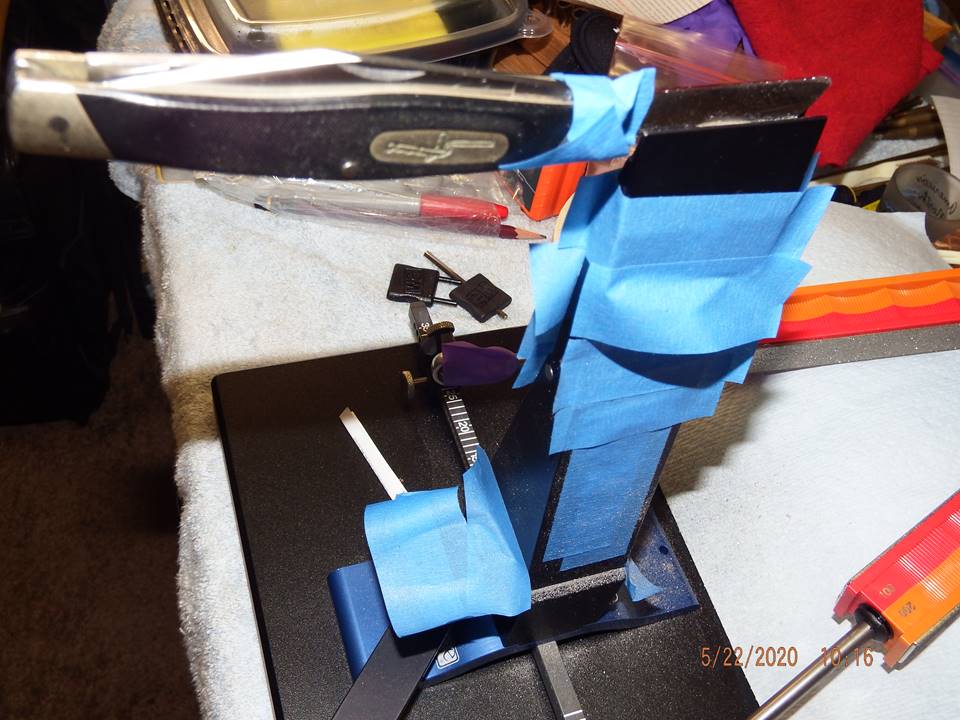Minimum Blade Width for 12 to 15 degree per side
Recent › Forums › Main Forum › Getting Started › Minimum Blade Width for 12 to 15 degree per side
- This topic has 16 replies, 5 voices, and was last updated 02/05/2021 at 10:48 am by
 000Robert.
000Robert.
-
AuthorPosts
-
01/20/2021 at 8:31 pm #55821
Disclaimer: I have never used the Wicked Edge Precision Knife Sharpener.
With a sharpener such as the Wicked Edge Precision Knife Sharpener, one of the limitations is the width of the blade. As an example, if you want to sharpen a blade at 15 degrees per side using the similar Worksharp product, you need roughly 20mm sticking out past the blade holder. The end result is that if you have something like a Case or Buck medium Stockman, or worse, a Buck Deuce (even smaller), you are out of luck if you want 15 degrees.
I see that the Wicked Edge Precision Knife Sharpener has a Low Angle Adapter. Is there a chart that shows how far above the knife holder a knife must protrude to sharpen at different angles? I measured these values for a review that I recently did for a different sharpener, but I do not buy things to review them, I buy them to use them. Sadly, it seems that most people that are posting reviews seem to not be sharpening knives such as these.
I did see that many people posted settings for submitted knives, but the ones that I checked that might be similar, were all in the neighborhood of 20 degrees. My Buck 722 with S30V steel is right around 15 degrees, but the blade is wide enough that I know that it will not have a problem on the Wicked Edge. I am not convinced that I could use it on my large batch of Case and Buck Stockmans that I just have not gotten around to sharpening since those are coming from the factory generally around 13 to 16 degrees per side.
The best that I have is that I need I need 5/8″ or 16 mm for 13 degrees. So not even close for my Stockman knives. How about 15 degrees? My guess is no since the clip blade on one of my Medium Case Stockman knives is only 3/8″ from edge to the back of the blade.
01/21/2021 at 4:32 am #55822I modified an old Lansky clamp so I could use it as a low angle adapter. I can easily get angles lower than 15 degrees on my stockman or other small pocket knives. Very easy to do and very cheap as well.
Frans
01/21/2021 at 4:54 am #55823For really narrow knives, even the LAA won’t solve the problem. The only solution to my knowledge is the Tormek Small Knife Adapter, which leaves the blade suspended in mid-air above the vise, where it is easily accessible. One of our senior members is Josh at RazorEdgeKnives. He once posted about how he used a Tormek SKA on top of a LAA. With this, he was able to get down near the 6 dps territory. Wider knives would let you reach even lower angles.
One caveat about the Tormek SKA is that folder blades which are not tightly held on their pivot pins may need some additional support. Since I sharpen one side at a time, I use the opposite side hand to steady the blade.
1 user thanked author for this post.
01/21/2021 at 6:25 am #55824I have a WE130 with the LAA and the only blade that I have a problem with on pocket knives is the spey blade. So I sharpen them by hand. Here is a photo where I have the sheepsfoot blade of my Buck 301 clamped up.

Attachments:
You must be logged in to access attached files.
01/21/2021 at 6:54 am #55827I do own a Tormek, and I have the knife jig. I was not aware that Tormek had come out with a “small” knife jig. Looks interesting.
000Robert, what angle are you using on your Buck 301?
Although I like the spey blade, it is one of the more difficult ones to sharpen on the Stockman.
01/21/2021 at 2:33 pm #55828I do own a Tormek, and I have the knife jig. I was not aware that Tormek had come out with a “small” knife jig. Looks interesting. 000Robert, what angle are you using on your Buck 301? Although I like the spey blade, it is one of the more difficult ones to sharpen on the Stockman.
I don’t remember what the angle was on the 301, probably around 15dps. I don’t keep track of pocket knife angles – I just find the angle and sharpen them to what they are and don’t worry about it.
It’s quicker and easier for me to just sharpen the spey blades by hand.
01/22/2021 at 12:35 pm #5583501/22/2021 at 12:44 pm #55836Spey blades were originally used to castrate animals. The shape should not catch on things that it should not. These days, I doubt if they are used for such, but it is still a common blade on the Stockman pattern knives. The Case small stockman almost always has a pen blade rather than a spey blade. On a stockman, the other two blades are always (I think) a clip and a wharncliffe.
I only know about spey blades because I like stockman knives.
1 user thanked author for this post.
01/22/2021 at 4:41 pm #55838Spey blades were originally used to castrate animals. The shape should not catch on things that it should not. These days, I doubt if they are used for such, but it is still a common blade on the Stockman pattern knives. The Case small stockman almost always has a pen blade rather than a spey blade. On a stockman, the other two blades are always (I think) a clip and a wharncliffe. I only know about spey blades because I like stockman knives.
My Buck 301 Stockman has a sheepsfoot blade instead of a wharncliffe.
01/23/2021 at 4:30 am #55840I have a rancher friend in NE Wyoming who carried a small Case folder which he used to convert bulls to steers. The blade was really slender, looking more like a Texas tickler after many, many sharpenings.
This would be one of those applications which would benefit from a toothier edge, maybe 800 grit.
1 user thanked author for this post.
01/23/2021 at 5:54 am #55841I have a rancher friend in NE Wyoming who carried a small Case folder which he used to convert bulls to steers. The blade was really slender, looking more like a Texas tickler after many, many sharpenings. This would be one of those applications which would benefit from a toothier edge, maybe 800 grit.
I put a toothy 800 or 1000 grit edge on all of my blades unless I plan on collecting them. I decided to collect my Boker Plus 74 Kalashnikov Damascus Auto, so I put mirrored edges on it as best as I could with what was included in my Pro Pack III.
Attachments:
You must be logged in to access attached files.
01/23/2021 at 6:16 am #55844I have a rancher friend in NE Wyoming who carried a small Case folder which he used to convert bulls to steers. The blade was really slender, looking more like a Texas tickler after many, many sharpenings. This would be one of those applications which would benefit from a toothier edge, maybe 800 grit.
Wowser, at my house, we used a scalpel, and it was goats, not cows….
01/23/2021 at 6:27 am #55845My Buck 301 Stockman has a sheepsfoot blade instead of a wharncliffe.
Grumble, operator head-space. Yes, Sheepsfoot (apparently designed for trimming sheep hooves), not a wharncliffe (designed for use by sailors is one story I have heard).
Not everyone agrees see https://blog.knife-depot.com/history-of-the-wharncliffe-blade/
01/23/2021 at 6:39 am #55846I heard that they called it a sheepsfoot blade because it is shaped like a sheep’s foot. It is good for cleaning horse hooves if I remember right.
01/23/2021 at 7:02 am #55847I heard that they called it a sheepsfoot blade because it is shaped like a sheep’s foot. It is good for cleaning horse hooves if I remember right.
I read that it looks like a sheepsfoot, but that feels like a stretch to me (read uneducated opinion based on not much). Understand that I also laugh at the ancient greeks (or whoever did this) who looked up into the sky and said “yeah, that square cluster of stars up there, that is a guy riding a horse with a bow”.
I never heard of anyone cleaning a horse hoof with a real knife. I used a farrier hoof knife often enough for the task, but that has a curved edge similar to a spoon (or bowl) carving knife (curves back in a U shape) or maybe more like those fake springy running legs / feet for people who lose a lower leg. Have not done it since the early 80’s so my memory is likely fuzzy at this point.
1 user thanked author for this post.
-
AuthorPosts
- You must be logged in to reply to this topic.
